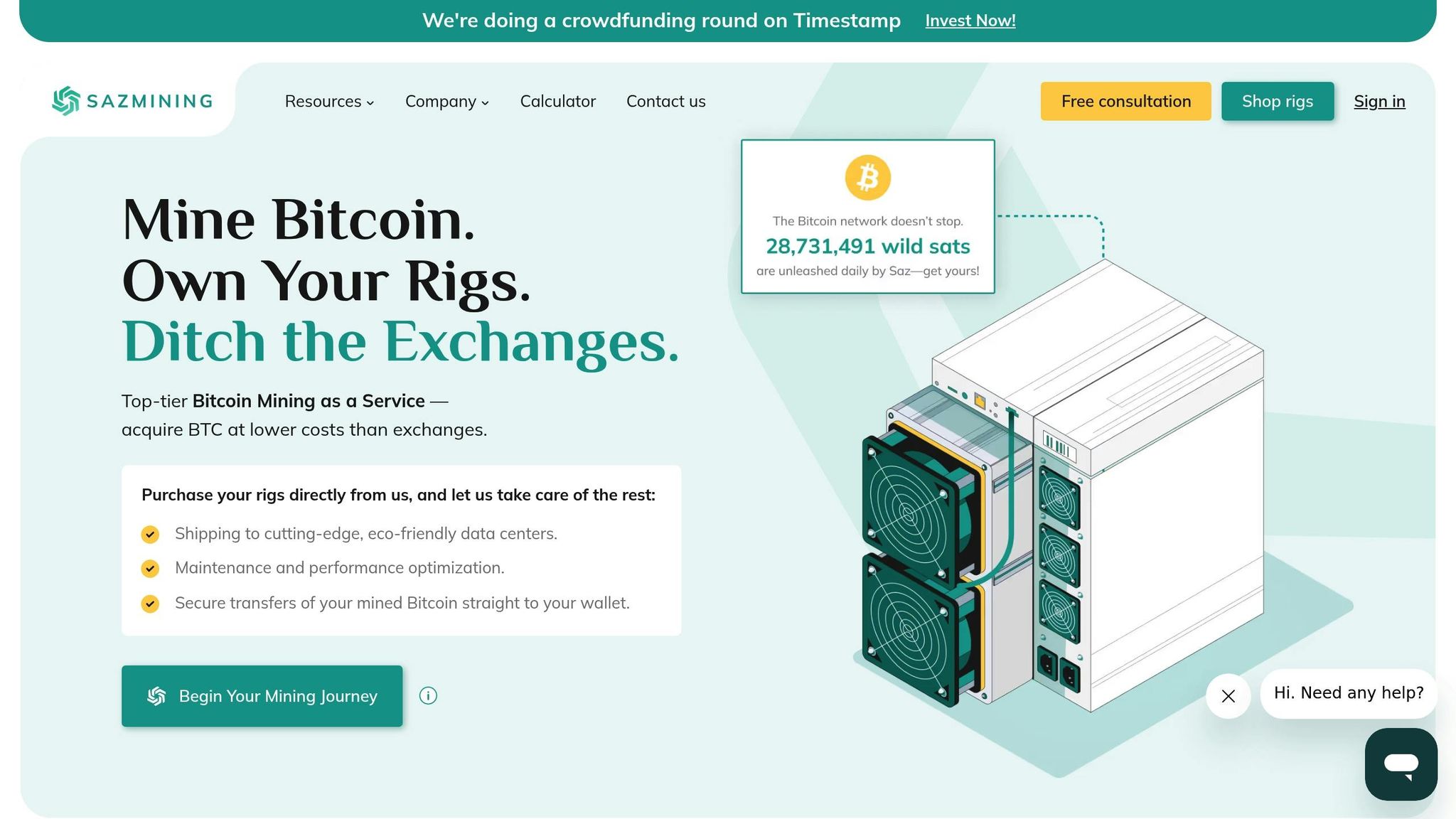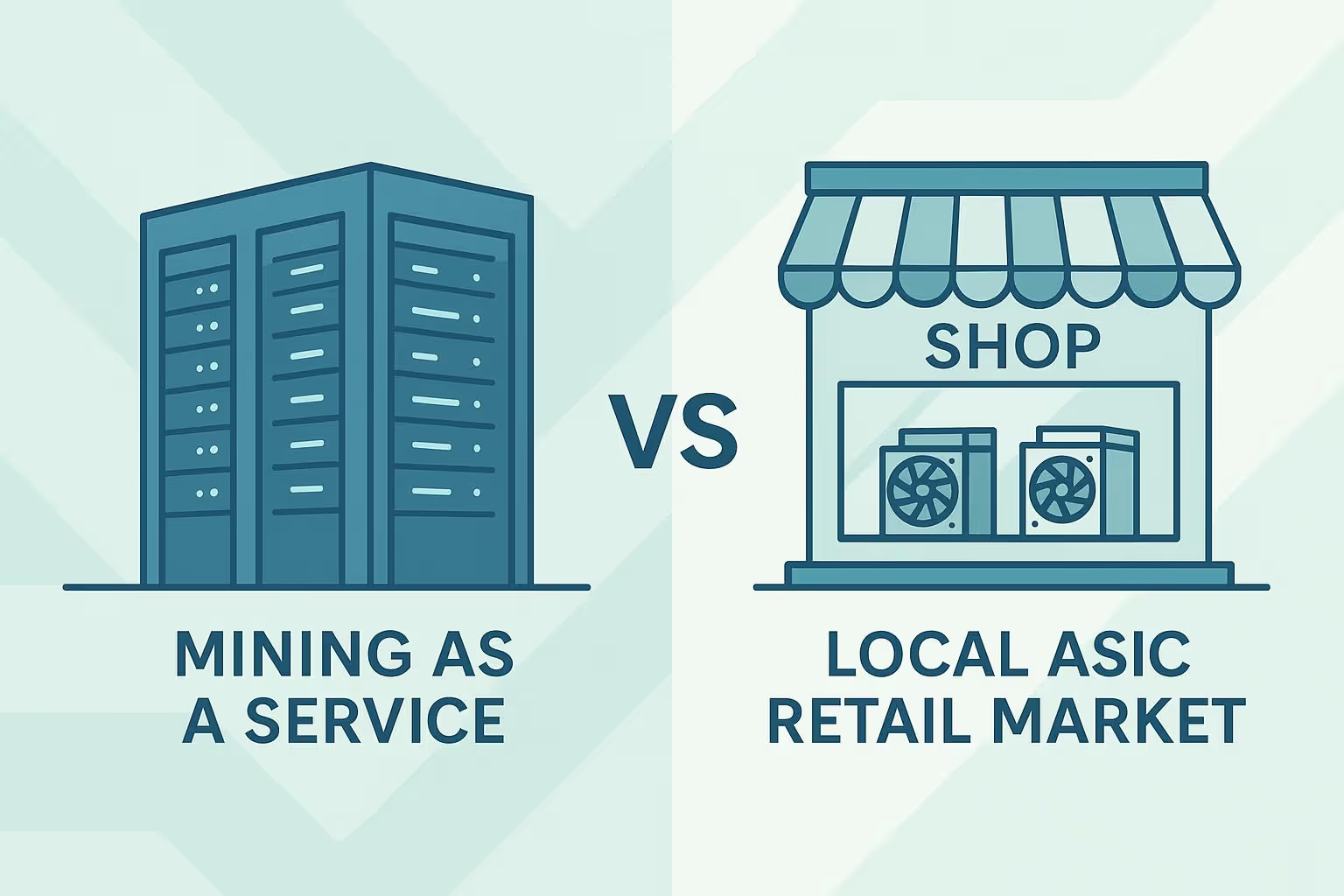Bitcoin mining in the U.S. mainly offers two choices: Mining as a Service (MaaS) or buying ASIC miners locally. Each option has its own pros and cons, depending on your budget, technical skills, and goals. Here’s the quick breakdown:
- MaaS (Mining as a Service): You rent mining equipment managed by a third-party provider. This option is hands-off, with lower upfront costs and predictable monthly fees. Providers like Sazmining even use renewable energy for operations.
- Local ASIC Mining: You buy and manage your own mining hardware. This gives you full control and potentially higher profits, but it requires a larger initial investment, technical know-how, and ongoing maintenance.
Quick Comparison
| Factor | MaaS | Local ASIC Mining |
|---|---|---|
| Initial Costs | $3,847–$3,997 plus setup fees | Higher upfront for hardware and setup |
| Ongoing Costs | $239–$250/month | Varies by electricity and maintenance |
| Scalability | Easy to expand without extra setup | Limited by space and electrical setup |
| Maintenance | Fully managed by the provider | You handle all upkeep and repairs |
| Energy Costs | Lower due to industrial contracts | Depends on local electricity rates |
| Technical Skills | Minimal required | High; requires hands-on involvement |
If you want convenience and minimal involvement, MaaS is a good option. If you prefer control and are ready to handle the challenges of hardware management, local ASIC mining might be better. Choose based on your budget, expertise, and how much time you’re willing to invest.
How Mining as a Service (MaaS) Works
MaaS Operations
Mining as a Service (MaaS) simplifies the often complex world of Bitcoin mining. Here’s how it works: you purchase mining hardware, but instead of managing it yourself, a professional provider takes care of everything. From hosting to maintenance, they handle the technical side. Once you’ve made your purchase, the mining equipment is sent to a specialized data center. There, technicians set it up, optimize its performance, and get it running to generate Bitcoin, with payouts sent directly to your wallet.
Most MaaS providers also offer tools for real-time monitoring. These tools let you keep an eye on hash rates, earnings, and the operational status of your equipment from anywhere, using online dashboards. This hands-off approach not only saves time but also cuts down on the headaches of managing hardware yourself.
Main Benefits of MaaS
MaaS levels the playing field, making Bitcoin mining accessible even if you don’t have a technical background. Another big perk is lower energy costs. Professional mining facilities often negotiate industrial-scale power contracts and use renewable energy sources, reducing electricity expenses compared to what you’d pay at home.
Scalability is another highlight. Want to increase your mining capacity? Just purchase more rigs through the platform - no need to worry about finding extra space or upgrading your electrical setup. Plus, the maintenance-free experience ensures your equipment runs at its best, minimizing downtime and maximizing returns.
One company that stands out in this space is Sazmining, offering a transparent and efficient model for its customers.
Sazmining's Service Features

Sazmining gives customers the ability to own their mining hardware, offering more control and potentially higher returns. Pricing is straightforward, with no hidden fees. For example, a Bitmain S19 XP Hydro (246 TH/s) costs $3,847, while the 257 TH/s variant is priced at $3,997. Monthly service fees are $239 and $250, respectively, and the company guarantees 90% annual rig performance.
Sazmining takes an environmentally conscious approach by running its operations on 100% hydropower in Paraguay. Their fully managed service covers everything - from setup to ongoing optimization. Their team continuously monitors performance, handles maintenance, and ensures Bitcoin payouts are sent directly to customers’ wallets without delays. This comprehensive service makes Bitcoin mining not just easier but also more efficient.
Buying ASIC Miners Locally: Ownership and Duties
Steps to Buy and Run ASIC Miners
If you're looking for full control over your mining setup, buying and managing ASIC miners locally might be the way to go. Unlike the hands-off convenience of MaaS (Mining as a Service), this approach puts you in charge of everything, from hardware selection to maintenance.
Getting started requires some planning. First, choose the right hardware based on your budget and mining goals. As of October 2025, two popular options include:
- Bitmain Antminer S21+: Priced at $4,150, it delivers a hash rate of 235 TH/s with a power consumption of 3,564W.
- MicroBT WhatsMiner M50S++: A more budget-friendly choice at $2,790, offering 160 TH/s and consuming 3,360W of power.
Once you've picked your hardware, calculate your electricity costs. Mining consumes a lot of energy, and since electricity rates vary across the U.S., it's crucial to figure out if mining will be profitable in your area.
You'll also need to prepare a dedicated space for your equipment. Proper ventilation and cooling are essential to handle the heat these machines generate. Setting up involves connecting the miner to power, networking it, and joining a mining pool to ensure steady payouts.
Local ASIC Mining Challenges
Running ASIC miners at home comes with its fair share of challenges. For starters, these machines are noisy and produce a lot of heat, which means you'll need a well-ventilated, dedicated area to house them.
High-performance models, like the Antminer S21 XP (3,645W), may even require electrical upgrades to handle their power needs. Beyond the setup, you'll also be responsible for all maintenance. This includes regular cleaning, fixing fan issues, and keeping the firmware updated to ensure the miner operates efficiently. Over time, your equipment will depreciate as newer, more efficient models enter the market, which is another factor to consider.
Who Should Choose Local ASIC Mining?
Local ASIC mining is ideal for tech-savvy individuals who enjoy hands-on management and have the skills to handle hardware and software configurations. If you live in an area with relatively low electricity rates, this method might also be cost-effective.
This option is particularly appealing to those who want full control over their mining operations, including managing their wallets and fine-tuning settings. It's also a good starting point for hobbyists who want to experiment with one or two miners before scaling up. However, be prepared for the demands of physical setup and ongoing maintenance. You'll need sufficient space, proper cooling, and the willingness to handle the inevitable challenges that come with running your own mining operation.
In contrast to the managed MaaS model, local mining offers a more hands-on experience, making it a great choice for enthusiasts who prioritize control and are willing to invest time and effort into the process.
MaaS vs Local ASIC Mining Comparison
Comparison Factors
When choosing between Mining as a Service (MaaS) and local ASIC mining, it’s important to weigh factors like initial costs, ongoing expenses, scalability, maintenance, energy efficiency, and accessibility. Initial costs refer to the upfront investment needed to begin, while ongoing costs include recurring monthly expenses. Scalability measures how easily you can grow your mining operation, and maintenance reflects the level of technical involvement required to keep things running smoothly. Energy efficiency not only affects profitability but also has an environmental impact. Accessibility, meanwhile, determines how beginner-friendly each option is.
By breaking down these factors, you can align your choice with your technical expertise, budget, and long-term goals. This sets the stage for a more detailed, side-by-side comparison of the two approaches.
Side-by-Side Comparison
Here’s a direct comparison of key metrics for MaaS versus local ASIC mining:
| Metric | Mining as a Service (MaaS) | Local ASIC Mining |
|---|---|---|
| Initial Costs | $3,847–$3,997 for the rig plus hosting setup (e.g., Sazmining pricing) | Includes hardware purchase and potential upgrades for electricity or facilities |
| Ongoing Costs | $239–$250 monthly service fees for hosting, maintenance, and support | Varies based on electricity rates and maintenance needs |
| Scalability | Easily expand by adding rigs without home upgrades | Limited by available space and residential electrical capacity |
| Maintenance | Fully managed by professional data centers | User handles all repairs and upkeep, including cleaning and troubleshooting |
| Energy Efficiency | Optimized data centers using renewable energy like hydropower | Depends on your home setup and local power grid conditions |
| Accessibility | Requires minimal technical knowledge | Requires advanced hardware skills and problem-solving abilities |
This comparison highlights the key differences between MaaS and local ASIC mining. MaaS provides predictable costs, covering hosting, maintenance, and operational support, making it a low-hassle solution. On the other hand, local mining comes with variable expenses, influenced by electricity rates and unexpected equipment issues.
Scalability is another major distinction. With MaaS, you can scale up quickly without worrying about upgrading your home’s electrical system. By contrast, local mining is often limited by the physical and electrical constraints of a residential setup. Maintenance responsibilities also differ significantly - MaaS providers handle everything from hardware repairs to firmware updates, while local miners must manage tasks like fan replacements, system cleaning, and network troubleshooting on their own.
sbb-itb-c71a7d0
How to Choose the Right Approach
Mining Goals and Budget
Your financial goals and budget play a big role in deciding between MaaS (Mining-as-a-Service) and local ASIC mining. If you prefer predictable monthly costs and want to avoid hefty upfront investments in hardware, MaaS might be the better fit. It eliminates unexpected expenses like equipment failures or the need for electrical upgrades, offering a more structured and stable financial plan.
On the flip side, local ASIC mining might appeal to those who can afford a larger upfront investment and want to avoid ongoing service fees. Think about how you like to manage payments - do you prefer smaller, consistent payments over time, or are you comfortable with a bigger initial cost and the possibility of fluctuating operational expenses later?
MaaS simplifies budgeting with fixed fees and reduces financial risks, while local mining involves a higher initial cost and potential risks like hardware depreciation and repair expenses. If you're planning to invest in Bitcoin mining for the long haul, consider how each option aligns with your portfolio goals and the returns you expect over several years.
Next, think about how your technical skills and the time you can dedicate to mining might influence your decision.
Technical Skills and Maintenance Preferences
Your technical know-how and willingness to spend time on maintenance are critical factors. Local ASIC mining requires hands-on involvement, including tasks like setting up networks, updating firmware, and performing routine maintenance.
This approach can demand several hours of work each week. When equipment breaks down, you might find yourself spending an entire weekend troubleshooting, ordering parts, or reconfiguring your setup. MaaS, on the other hand, takes these responsibilities off your plate. With experienced technicians handling the technical side, you can focus on tracking your mining returns through an easy-to-use dashboard.
Ask yourself how comfortable you are with learning and solving technical problems. If you enjoy diving into technical challenges, local ASIC mining could be a rewarding experience. But if you’d rather take a more hands-off approach, MaaS offers a more passive way to invest without the need for technical involvement.
This brings us to another key consideration - energy efficiency and its impact on the environment.
Energy Efficiency and Environmental Goals
For many investors, reducing environmental impact is becoming a priority. Sazmining’s facilities in Paraguay run entirely on 100% hydropower, making it a cleaner energy option that helps lower your carbon footprint compared to using standard residential electricity. This renewable energy model is ideal for those who want to invest in Bitcoin while minimizing their reliance on fossil fuels.
Professional mining facilities generally have better energy efficiency, ensuring that more electricity goes toward mining rather than cooling or other infrastructure needs. They also often benefit from optimized energy contracts, which can result in lower costs compared to residential electricity rates.
However, local mining setups may be affected by local energy policies and regulations, which could influence both costs and environmental impact.
Seriously, is buying mining hardware even worth it?
Conclusion: Making the Right Choice
Deciding between these approaches comes down to your personal mining strategy and what aligns with your financial goals, technical know-how, and available time.
MaaS (Mining as a Service) provides a straightforward option for those who want to dive into Bitcoin mining without the hassle of owning and maintaining hardware. With predictable monthly costs, professional upkeep, and the added bonus of renewable energy from Sazmining’s hydropower facilities in Paraguay, this option offers a simpler, more regulated way to get started. It’s an excellent fit for beginners who want to focus on performance and learning rather than dealing with the complexities of mining equipment.
On the other hand, local ASIC mining is ideal for those who value having complete control over their mining equipment and are comfortable handling the maintenance and troubleshooting that comes with it. This route works best if you have the right electrical setup, technical expertise, and time to dedicate to managing your rigs. Ultimately, this choice emphasizes the importance of tailoring your mining strategy to match your financial and technical situation.
For U.S.-based miners looking for an eco-conscious and hands-off solution, Sazmining offers transparent pricing and full-service management, making it a compelling option.
Take a close look at your budget, technical skills, and long-term goals. Whether you choose MaaS or local ASIC mining, both can be effective and profitable when they align with your individual needs and circumstances.
FAQs
What should I consider when choosing between Mining as a Service (MaaS) and buying ASIC miners locally?
When choosing between Mining as a Service (MaaS) and purchasing ASIC miners locally, it’s essential to consider your goals, budget, and level of expertise.
With MaaS, you can rent hash power without the hassle of owning or maintaining hardware. This makes it a more accessible, low-maintenance option, especially for those new to mining or looking for a hands-off approach. Plus, scaling up as your mining needs increase is typically simpler with MaaS.
On the flip side, buying ASIC miners requires a hefty upfront investment but gives you complete control over the equipment. This can lead to better long-term profitability, but it comes with its own set of challenges - like handling maintenance, covering energy costs, and finding space for the hardware.
If convenience and minimal involvement are your priorities, MaaS might be the way to go. However, if you're ready to take on the technical and logistical responsibilities, owning ASIC miners can provide greater control and flexibility for your mining endeavors.
How does Mining as a Service (MaaS) compare to running ASIC miners at home in terms of energy efficiency, costs, and environmental impact?
Mining as a Service (MaaS) tends to be more energy-efficient compared to using ASIC miners at home. This is largely because MaaS providers operate in professional data centers designed to optimize power use and cooling. These centers often have access to cheaper electricity rates and may even rely on renewable energy sources, which helps lower costs and reduces environmental impact.
On the other hand, mining at home usually comes with higher electricity expenses due to standard residential rates and less effective cooling systems. The environmental impact of home mining also depends heavily on the energy mix of the local grid - regions relying on fossil fuels could result in a larger carbon footprint. For individuals looking to cut expenses and prioritize sustainability, MaaS offers a more cost-effective and eco-conscious alternative.
What are the technical skills and maintenance responsibilities for local ASIC mining compared to the convenience of Mining as a Service (MaaS)?
Local ASIC mining demands a good grasp of hardware setup, network configuration, and regular upkeep. You’ll need to install and fine-tune the ASIC hardware, keep an eye on its performance, and tackle challenges like overheating, power usage, and potential hardware breakdowns. This hands-on approach can take up a lot of time and often calls for solid troubleshooting skills.
On the other hand, Mining as a Service (MaaS) offers a much simpler, hassle-free alternative. With MaaS, you rent mining power from a provider, skipping the need to buy, set up, or maintain any physical equipment. It’s a great option for those who want to avoid the technical workload and enjoy a more streamlined experience.

